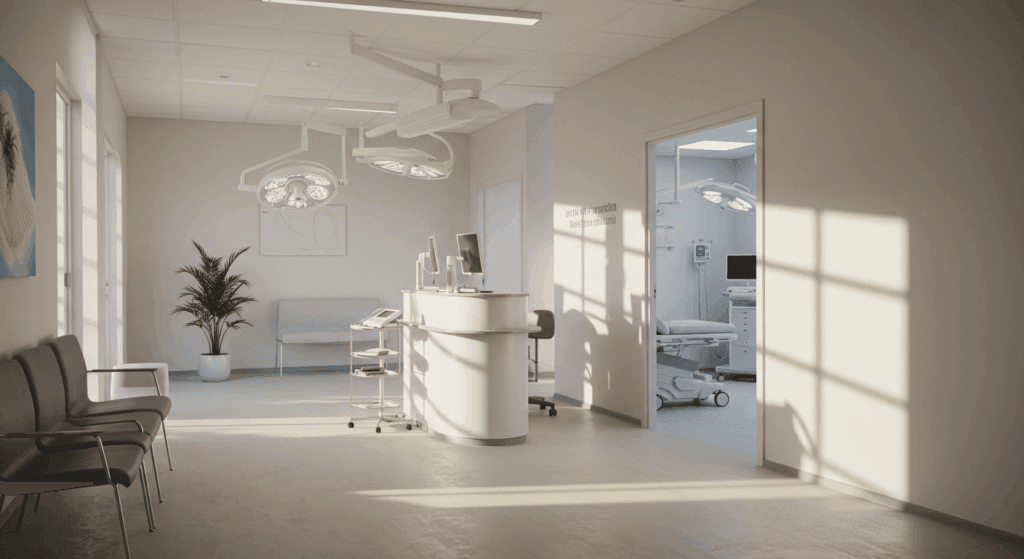Imagine waking up to a reflection that mirrors the vitality you feel inside—smoother skin, defined contours, and a refreshed glow that turns back the clock without looking “done.” In 2025, facelift surgery, also known as rhytidectomy, continues to evolve as one of the most sought-after cosmetic procedures for combating visible signs of aging. With advancements in techniques like deep plane lifts and hybrid thread methods, patients can achieve natural-looking results that enhance rather than alter their features. According to recent statistics, interest in facelift surgery has surged, with monthly search volumes reaching up to 30,000 in key markets, reflecting a post-pandemic boom in aesthetic enhancements. This comprehensive guide explores everything from the basics of facelift surgery to recovery, risks, and innovative options, including medical tourism for UK patients seeking affordable, high-quality care abroad. Whether you’re exploring “what is a facelift surgery” or weighing “facelift recovery time,” we’ll provide evidence-based insights drawn from leading medical authorities like the American Society of Plastic Surgeons (ASPS) and recent studies to help you make informed decisions. Remember, this article is for educational purposes only—always consult a qualified healthcare professional for personalized advice.

Table of Contents
Foundational Understanding of Facelift Surgery
Facelift surgery is a surgical intervention aimed at addressing sagging skin, deep folds, and loss of facial volume to restore a more youthful appearance. Technically termed rhytidectomy, it focuses on the lower two-thirds of the face and neck, tightening underlying tissues and removing excess skin. Unlike non-surgical treatments such as fillers or Botox, which offer temporary fixes, a facelift provides long-lasting structural changes that can endure for 10 to 15 years, depending on factors like lifestyle and genetics. The procedure doesn’t halt aging but repositions tissues to counteract gravity’s effects, resulting in a rested, natural look.
Prevalence of facelift surgery has grown significantly in recent years. In the U.S. alone, over 234,000 facelifts were performed in 2023, with a 5% increase from the previous year, and similar trends are observed globally, including in the UK where demand among those aged 40-65 has risen post-COVID. Women account for about 93% of procedures, but male interest is climbing, now at 7%, as societal norms evolve toward self-care. Demographically, it’s most common among middle-aged professionals in urban areas like London or Manchester, where maintaining a youthful image supports career and social dynamics.
Historically, facelifts date back to the early 20th century, with pioneers like Eugen Holländer performing skin excisions in 1901. By the 1970s, techniques advanced to include muscle tightening (SMAS layer), and the 21st century brought minimally invasive options like thread lifts. Recent developments from 2020-2025 emphasize natural aesthetics, with studies highlighting deep plane facelifts for superior longevity and reduced “pulled” appearances. Innovations such as the multiplane thread facelift, combining traditional methods with advanced threads, have gained traction for their ability to address multiple facial layers simultaneously, as presented at conferences like AMWC 2025.
These advancements stem from a deeper understanding of facial anatomy, where surgeons now prioritize repositioning rather than just pulling skin. For instance, a 2025 systematic review noted that tranexamic acid (TXA) use during surgery reduces bruising, enhancing recovery without increasing necrosis risks when properly managed. This evolution makes facelifts more accessible and appealing, bridging the gap between invasive surgery and subtle enhancements.
In the UK context, where NHS rarely covers cosmetic procedures, private facelifts cost £7,000-£15,000, driving interest in medical tourism. Turkey, a hub for aesthetic surgery, attracts over 1 million international patients annually, with facelifts comprising a significant portion due to costs 50-70% lower than in the UK. However, choosing certified surgeons is crucial for safety.

Clinical Aspects: Understanding Facial Aging
Facial aging is a multifaceted process influenced by intrinsic and extrinsic factors. Intrinsically, genetic predispositions lead to decreased collagen production starting in the late 20s, reducing skin elasticity by about 1-2% per year after age 30. Extrinsically, sun exposure accelerates this by breaking down elastin fibers, while smoking restricts blood flow, exacerbating wrinkles. Gravity plays a role too, causing tissues to descend, forming jowls and nasolabial folds.
Pathophysiologically, aging involves atrophy of subcutaneous fat, weakening of the superficial musculoaponeurotic system (SMAS), and bone resorption in areas like the jawline. This creates a “squarer” face shape from the youthful inverted triangle, with volume loss in cheeks leading to hollowing. Studies from 2020-2025 link hormonal changes, especially in menopause, to accelerated fat redistribution, affecting 60% of women over 50.
Signs and symptoms manifest as sagging skin around the jaw (jowls), deepened lines from nose to mouth, loose neck skin (“turkey neck”), and drooping eyelids or brows. These are often subtle at first, noticed in photos or mirrors, prompting self-consciousness. A 2025 epidemiological study found obesity increases complication risks, while sun-damaged skin heightens uneven healing.
Stages of facial aging can be classified using scales like the Glogau classification: Type I (minimal wrinkles, early 20s-30s), Type II (wrinkles in motion, 30s-40s), Type III (wrinkles at rest, 50s+), and Type IV (severe wrinkles, 60s+). Facelifts are typically ideal for Type II-III, where non-surgical options fall short.
Common misconceptions include the idea that facelifts create a “frozen” look—this stems from outdated techniques. Modern approaches, like deep plane lifts, preserve natural expressions by working deeper layers, as evidenced in a 2025 review of 78 cases showing high satisfaction rates. Another myth is that facelifts are only for the elderly; increasingly, patients in their 40s opt for preventive mini-lifts.
Diagnostic Approach to Facelift Candidacy
Assessing candidacy begins with a thorough consultation, where surgeons evaluate skin quality, bone structure, and overall health. Screening involves medical history reviews for conditions like diabetes or hypertension, which could impair healing—studies show smokers have 12% higher complication rates.
Diagnostic tests may include blood work, ECG for older patients, and imaging like 3D facial scans to simulate outcomes. Interpretation focuses on asymmetry, volume loss, and elasticity; for example, pinch tests gauge skin laxity.
Differential diagnoses rule out non-aging issues, such as thyroid disorders causing neck fullness or allergies mimicking puffiness. Psychological evaluation ensures realistic expectations, as body dysmorphic disorder affects 10-15% of cosmetic seekers.
In medical tourism contexts, like UK patients traveling to Turkey, virtual consultations via platforms like Zoom allow initial assessments, followed by in-person exams upon arrival.
Management Strategies for Facial Rejuvenation
Treatment options span surgical and non-surgical. Traditional facelifts involve incisions along the hairline and ears, repositioning SMAS and removing excess skin, taking 2-4 hours under general anesthesia. Deep plane facelifts, trending in 2025, dissect deeper for natural results, lasting 10-15 years with lower revision rates.
Mini facelifts target mid-face with shorter scars and quicker recovery (1-2 weeks), ideal for early aging, while thread lifts use dissolvable sutures for minimal downtime but shorter effects (1-3 years). Hybrid approaches, like multiplane thread facelifts, combine threads with traditional methods for multi-layered rejuvenation.
Non-surgical alternatives include fillers (e.g., hyaluronic acid) for volume, Botox for wrinkles, and lasers for skin texture, delaying surgery by 5-10 years but not matching surgical longevity.
Lifestyle modifications enhance outcomes: UV protection prevents 80% of photoaging, a balanced diet supports collagen, and quitting smoking improves circulation. Preventive measures like skincare routines start in the 30s.
Monitoring involves follow-ups at 1 week, 1 month, and 6 months, with photos tracking progress.
Practical Considerations After Facelift Surgery
Living with post-facelift changes means adapting to swelling (peaks at day 3, resolves in 2 weeks) and numbness (up to 6 months). Impact on daily life is minimal after 2-3 weeks, though strenuous activity waits 4-6 weeks.
Support resources include patient forums, ASPS guides, and apps for tracking recovery. Costs in the UK average £10,000, while in Turkey, packages start at £3,000-£6,000, including transfers and aftercare. Insurance rarely covers cosmetics, but some policies include complications.
For UK patients in Turkey, clinics like Dr. Berat Çiğdem’s offer all-inclusive packages with ISAPS-certified care, private nursing, and 7/24 support, addressing logistics fears.
Special Populations in Facelift Surgery
Pediatric facelifts are rare, typically for congenital issues, not aging. Geriatric patients (65+) require cardiac clearance, with studies showing higher hematoma risks but good outcomes if healthy.
Pregnancy contraindicates surgery due to anesthesia risks; wait 6 months postpartum. Comorbidities like obesity demand weight management, as a 2025 study linked BMI>30 to 15% higher infections.
Men, with thicker skin, benefit from tailored techniques for natural results, increasingly popular.

Medical Tourism: Facelift Options for UK Patients in Turkey
Turkey’s medical tourism boom sees 1.2 million visitors yearly for cosmetics, with facelifts popular due to expertise and affordability—savings up to 70% vs. UK. Accredited clinics meet international standards, but risks include communication barriers; choose English-speaking teams.
Dr. Berat Çiğdem exemplifies excellence: ISAPS member, Harvard-trained, with 10+ years in facial aesthetics. His Antalya clinic offers natural-focused facelifts, all-inclusive packages with sigorta, addressing UK patients’ concerns like safety and follow-up.
Pros: Cost, combined holidays; cons: Travel recovery, potential complications abroad. UK government advises researching via TikTok campaigns.
Comparison Table: Facelift Costs and Features UK vs. Turkey
| Aspect | UK | Turkey |
|---|---|---|
| Average Cost | £7,000-£15,000 | £3,000-£6,000 |
| Package Inclusions | Surgery only | Transfers, hotel, follow-ups |
| Recovery Support | Local clinics | 24/7 coordinators, nursing |
| Risks | Standard | Travel-related; mitigated by accreditation |
When to See a Doctor and Questions to Ask
Seek consultation if aging signs affect confidence. Red flags post-surgery: Excessive swelling, infection.
Questions for your provider: “What technique suits me?” “What’s the recovery timeline?” “Are you board-certified?”
Key Takeaways Box:
- Facelifts last 10-15 years with natural results.
- Deep plane techniques are 2025’s trend for longevity.
- Medical tourism in Turkey saves costs but prioritize certified surgeons.

Conclusion
Facelift surgery in 2025 offers transformative, natural rejuvenation, blending time-tested methods with innovations like hybrid threads to address aging’s physical and emotional tolls. From understanding causes and procedures to navigating recovery and costs, this guide empowers you to explore options confidently. For UK patients, destinations like Turkey provide accessible excellence, as seen in practices like Dr. Berat Çiğdem‘s, emphasizing safety, comfort, and personalized care. Prioritize consultations with certified experts—your journey to a refreshed self starts with informed steps. Consult a professional to tailor these insights to your needs, and embrace aging gracefully on your terms.
References
- American Society of Plastic Surgeons. (2025). Facelift Overview. Retrieved from https://www.plasticsurgery.org/cosmetic-procedures/facelift
- Cleveland Clinic. (2023). Facelift (Rhytidectomy). Retrieved from https://my.clevelandclinic.org/health/treatments/11023-facelift
- Mayo Clinic. (2022). Face-lift. Retrieved from https://www.mayoclinic.org/tests-procedures/face-lift/about/pac-20394059
- Recent Trends in Facelift Procedures. (2025). PMC Articles.
- Epidemiological Factors in Facelift Surgery. (2025). Springer Link.
- Medical Tourism Statistics in Turkey. (2025). UK Smiles.

